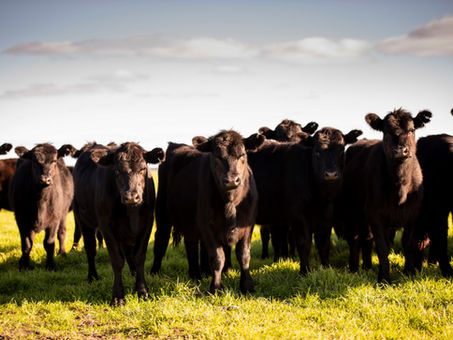
Utilising Heifer Pre-Mating Serology to Manage Bovine Pestivirus (BVDV)
MLA Producer Demonstration Site
2023 - 2029
Project Facilitator: Dr Enoch Bergman
Lead Producer: Todd Quinlivan
ASHEEP & BEEF Coordinator: Sarah Brown
Updated 10/12/25
Utilising Heifer Pre-Mating Serology to Manage BVDV is a 6 year project, run by ASHEEP & BEEF in collaboration with Swans Veterinary Services and local producers, and funded by Meat & Livestock Australia (MLA) through the Producer Demonstration Site program.
The project aims to demonstrate the value of utilising serology for Bovine Pestivirus (BVDV) to both define the risks specific to individual cohorts of heifers prior to mating and to guide producers to both identify and appreciate the most cost-effective intervention depending upon those results. The overarching goal is to improve producer awareness of the pathophysiology of BVDV, how it is transmitted and maintained on properties and between production systems, a greater understanding of the costs attributable to BVDV infection, and a greater understanding of how serology, PI screening, vaccination, and biosecurity protocols can assist them in controlling BVDV.
In summary, producers will be able to:
-
Schedule pre-mating heifer BVDV serology.
-
Understand how to interpret their BVDV serological results.
-
Understand when it is appropriate to integrate BVDV vaccines into heifer pre-mating protocols.
-
Understand when it is appropriate to integrate PI screening into heifer pre-mating protocols.
-
Explain how BVDV is transmitted and maintained within and between production systems.
-
Explain how Persistently Infected (PI) animals are produced.
-
Understand the role of PI’s in the spread of BVDV within and between production systems.
PROJECT PARTNERS:



Background
Bovine Pestivirus was listed as the second most expensive endemic disease within the Australian beef herd, with an estimated annual cost of $114.4 million AUD. (B.AHE.0010). Early survey works suggests that approximately 90% of Australian beef and dairy production systems have evidence of past exposure to Bovine Pestivirus. Survey work conducted in Esperance by Swans Veterinary Services from 2004 to 2006 demonstrated that 75% of the 150 properties sampled had evidence of past exposure to BVDV.
Pre-breeding cohort serology provides a cost-effective value proposition for producers to choose the best management practice for each new group of replacement heifers annually. Both awareness and compliance among producers for active systematic Bovine Pestivirus management remains very low nationally. Currently, awareness and compliance within the Esperance district is low, in line with national statistics of vaccine usage from Zoetis (the only commercial manufacturer of the vaccine).
Project objectives
By December 2028, in the Esperance Region of Western Australia:
-
Conduct pre-mating BVDV serology survey over three seasons on at least 30 beef enterprises located within the geographically isolated Esperance shire.
-
Define the range of serological results.
-
Record the proportion of core and observer producers involved in the survey that have either implemented vaccination programs or screened their replacement heifers to ensure none of them are Persistently Infected prior to mating, depending upon the results of their pre-mating serology.
-
Measure pregnancy testing and calf wastage between pregnancy testing to weaning data from all properties which participate in the PDS and compare the results between the three groups (those that vaccinate, those that PI test, and those that choose to do nothing).
-
Demonstrate that over the course of the PDS, a higher proportion of the replacement heifer management groups with active intervention (vaccination or PI screening) will render seronegative pre-mating serological results in subsequent annual screening indicating that their interventions have been successful compared to enterprises which chose to do nothing.
-
Conduct annual field days and other activities to share the ongoing results of the annual serosurvey, pregnancy data, calf wastage data and to showcase the individual progress of the Core producers with demonstration sites encouraging ongoing adoption and enrolment amongst observer producers by the close of the project.
-
Develop an economic analysis of measured losses between pregnancy testing and weaning, and potentially of pregnancy testing data, catering for differences in joining period length.
-
Conduct a pre and post project KASA survey to gauge understanding of the pathophysiology of the syndrome and the steps that can be taken to mitigate it. These surveys will be used to demonstrate that a target of 100% core producers and 70% of observer producers have improved their knowledge and skills in understanding how BVD is maintained and propagated within and between production systems, affect profitability, and how to measure their risk profile of harbouring BVDV in the Esperance area.
-
We will aspire to 80% of core producers adopting a BVDV management strategy and 50% of observer producers intending to adopt a BVDV management strategy.
There are opportunities throughout the project for producers to attend workshops, tours and field days.
This project has animal ethics approval via the Department of Primary Industry & Regional Development Animal Ethics Committee.
Banner Image Credit: Dan Paris.
PROJECT UPDATES:
Contact ASHEEP & BEEF if you would like more information on this project. ASHEEP & BEEF members will be provided with regular updates, visit our membership page if you would like to consider joining.
PROJECT PARTNERS:




%20Producer%20Guide%20V1_1_Page_1.jpg)











